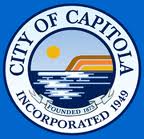Urban stormwater management in the City of Capitola
Contents
Capitola
The village of Capitola became the third incorporated city in Santa Cruz County in January 1949. As such, the city of Capitola is required to have a Storm Water Management Program (SWMP) for pollutants, sediment, and toxins from urban discharges. The County of Santa Cruz and the City of Capitola are collaborating to address the new statewide National Pollutant Discharge Elimination System (NPDES) General Permit [1] requirements for agencies designated by the State Water Resources Control Board (SWRCB).
Summary
The City of Capitola relies on Santa Cruz County to provide major storm drain services through the Santa Cruz County Flood Control & Water Conservation District Zone 5 [2]. Existing infrastructure used to manage floods and storm water drainage includes: above ground drainage ditches and water courses; pump stations, catch basins and outfalls. Five main storm drain outfalls discharge storm water into Soquel Creek. Three outfalls flow directly to the Capitola Beach and four outfalls discharge storm water onto the coastal cliffs near Grand Avenue and Cliff Drive. In 2002, the City of Capitola received a grant from the SWRCB for $100,000 to create a master plan for the storm drains in the Village area. The master plan identifies key water quality components and outlines the design and building specifics for dry weather diversions. In 2004, Capitola also constructed the "Lawn Way" pump station in order to alleviate localized flooding. A bio-filtration treatment wetland was built in 2008 tangential to Soquel Lagoon with the goal of improvements to lagoon water quality and help treat stormwater. In March of 2011, The City of Capitola experienced major flooding in the Village when the Nobel Gulch Drain Inlet failed. Corrections are being made through the installation of new infrastructure and increased monitoring and maintenance.
Watersheds
- Soquel Creek
- Nobel Gulch
- Arana-Rodeo Gulch
Stakeholders
- Central Coast Regional Water Quality Control Board
- County of Santa Cruz, Department of Environmental Health
- County of Santa Cruz, Department of Public Works
- Santa Cruz County Sanitation District
- City of Capitola Public Works Department
- California Coastal Commission [2]
- Soquel Creek Water District
- Santa Cruz Water Department
- Capitola Village Resident’s Association
- Capitola Village Wharf and Business Improvement Association
- Save Our Shores
- Ecology Action
- Coastal Watershed Council
- Resource Conservation District of Santa Cruz County(RCDSCC)
- This organization addresses local natural resource issues through a local partnership with the Natural Resources Conservation Service (NRCS). The Resource Conservation District currently has two programs that address habitat restoration: the Healthy Watersheds Restoration Program (HWRP) focuses on smaller-scale restoration projects, while the Integrated Watershed Restoration Program (IWRP) focuses on larger-scale restoration projects.
Regulatory Background
Many have been implemented and enforced over the last few decades to reduce pollutants and contaminants being discharged into the Soquel Creek, and upper Arana-Rodeo Culch Watershed. For more information on Federal and State laws regulating storm water, see urban stormwater laws and policies.
Regional
- County of Santa Cruz Stormwater Program
- Storm Water Resources[3]
- BASMAA’s Start at the Source Manual[4]
- Storm Water Best Management Practice Handbooks [5]
- Rainfall and Stream Data [6]
Local
The 2008 Capitola Draft Stormwater Management Plan denoted policies to implement best management practices: [2]
- Maintain drainage infrastructure
- Outfall inspection and cleaning
- Annual storm drain cleaning every fall
- Zero discharge sidewalk cleaning
Currently the City of Capitola's NPDES program is unfunded.
This will impact:
- Developing accurate drainage system maps
- Implementing Soquel Creek Lagoon Management Plan
- Improving Soquel Creek water quality
TMDL information:
- TMDL Document for Soquel Lagoon, Soquel Creek, And Noble Gulch Fecal Coliform
- Cumulative TMDLs by Pollutant California, San Lorenzo-Soquel Watershed
Regulatory Timeline
Stormwater Management Program
- 2003 (March) SWMP submitted to the RWQCB
- Comments received from the Regional Board in January 2004.
- Revised and resubmitted SWMP in May 2004.
- No communication from the Regional Board until Feb 2008.
- Santa Cruz County & City of Capitola
- 2003 Replaced sewer lines along the downtown Esplanade area.
- 2004 Village Drainage Improvement Plan drafted.
- 2004-2006 Coastal Non-point Source Pollution Control Grant provided by Proposition 13 funds.
- 2005 The City conducted wet weather and dry weather video analysis of sewer lines adjacent to Soquel Creek.
- 2007 The City receives a second Clean Beaches Grant to implement key projects identified in the Village Drainage Improvement Plan. Capitola used the grant to construct a treatment 1/4 acre wetland on city owned property adjacent to Soquel Lagoon in the downtown area.
- 2008 Second round of sewer line replacement along the downtown Esplanade area.
Resources at Stake
Key relevant resources:
- Wildlife health
- Beach goer health and safety
- Disease vectors
Management Strategies
- 'Slow it, Spread it, Sink it' A Homeowner’s Guide to Greening Storm Water Runoff
- Capitola Storm Water Treatment Wetland
- Designed by Kestrel Consultingand funded in part by the California State Water Resources Control Board. The man-made wetland treats water from Soquel Creek and two storm drains prior to discharge to the Soquel Lagoon. The Coastal Watershed Council provides ongoing water quality monitoring.
References
- ↑ CONSTRUCTION STORM WATER PROGRAM
- ↑ 2.0 2.1 City of Capitola General Plan Update, 2011 [1]
Links
- ENVS 560/L Watershed Systems
- Urban stormwater regulations applicable to central coast region
- Urban stormwater management in the City of Scotts Valley
- Urban stormwater management in the City of Santa Cruz
- Urban stormwater management in the City of Watsonville
- Urban stormwater management in the Monterey Bay region
- Urban stormwater management in Santa Cruz County
- Urban stormwater management in the City of Pacific Grove
Disclaimer
This page may contain student work completed as part of assigned coursework. It may not be accurate. It does not necessary reflect the opinion or policy of CSUMB, its staff, or students.

